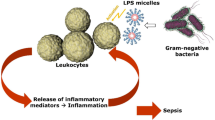Summary
The levels of endotoxin in blood were determined using the Limulus lysate test in combination with a chromogenic substrate. Plasma was analyzed from four patients with fatal meningococcal septicaemia and from one patient who survived meningococcal meningitis. All septicaemia patients showed high levels of endotoxin in their blood during the early stage of their disease. In two of these patients, blood samples collected at intervals of two days revealed a gradual disappearance of measurable endotoxin from the circulation. The patient with meningitis had no clinical signs of circulatory deficiency or coagulopathy and was consistently negative for endotoxin using this test procedure. Pretreating the plasma with heat and alkali and combining the Limulus lysate test with a chromogenic substrate seem to provide a sensible method for the detection and quantitation of endotoxin in blood.
Zusammenfassung
Der Limulus-Lysat-Test wurde in Kombination mit chromogenem Substrat zur quantitativen Bestimmung von Endotoxin im Blut eingesetzt. Die Untersuchung wurde an Plasma von vier Patienten mit tödlicher Meningokokkensepsis und einem Patienten, der eine Meningokokkenmeningitis überlebte, durchgeführt. Bei allen Patienten mit Sepsis fanden sich im Frühstadium der Erkrankung hohe Endotoxinspiegel im Blut. Bei zwei dieser Patienten war in Blutproben, die in zweitägigen Abständen entnommen wurden, ein schrittweises Verschwinden meßbaren Endotoxins aus dem zirkulierenden Blut festzustellen. Bei dem Patienten mit Meningitis bestanden keine Zeichen für ein Kreislaufversagen oder Koagulopathie; der Endotoxin-Test mit der genannten Methode war bei ihm ständig negativ. Bei Hitze- und Alkalivorbehandlung des Plasmas und Kombination mit chromogenem Substrat scheint der Limulus-Lysat-Test eine empfindliche Methode für den Nachweis und die quantitative Bestimmung von Endotoxin im Blut zu sein.
Similar content being viewed by others
Literature
Jørgensen, J. H. Current status of the Limulus Amoebocyte lysate endotoxin test. clin. Microbiol. Newsletter 3 (1981) 31–33.
Elin, R. J., Robinson, R. A., Levine, A. S., Wolff, S. M. Lack of clinical usefulness of the Limulus test in diagnosis of endotoxemia. N. Engl. J. Med. 293 (1975) 521–524.
Levin, J., Tomasulo, P. A., Oser, R. S. Detection of endotoxin in human blood and demonstration of an inhibitor. J. Lab. Clin. Med. 75 (1970) 903–911.
DuBose, D. A., Lemaire, M., Basamania, K., Rowlands, J. Comparison of plasma extraction techniques in preparation of samples for endotoxin testing by the Limulus Amoebocyte lysate test. J. Clin. Microbiol. 11 (1980) 68–72.
Friberger, P., Knös, M., Mellstam, L. A quantitative endotoxin assay utilizing LAL and a chromogenic substrate. Prog. Clin. Biol. Res. 93 (1982) 195–206.
Ohki, M., Nakamura, T., Morita, T., Iwanaga, S. A new endotoxin sensitive factor associated with hemolymph coagulation system of horseshoe crab(Limulidae). FEBS Lett. 120 (1980) 217–220.
Iwanaga, S., Morita, T., Harada, T., Nakamura, S., Niwa, M., Takada, K., Kimura, T., Sakakibara, S. Chromogenic substrates for horseshoe crab clotting enzyme. Haemostasis 7 (1978) 183–188.
Takagi, K., Moriya, A., Tamura, H., Nakahara, C., Tanaka, S., Fujita, Y., Kaway, T. Quantitative measurement of endotoxin in human blood using synthetic chromogenic substrates for horseshoe crab clotting enzyme. Thromb. Res. 23 (1981) 51–57.
Obayashi, T., Kawai, T., Tamura, H., Nakahara, G. New Limulus Amoebocyte lysate test for endotoxaemia. Lancet I (1982) 289.
Scully, M. F., Newman, Y. M., Clark, S. E., Kakkar, V. V. Evaluation of a chromogenic method for endotoxin measurement. Thromb. Res. 20 (1980) 263–270.
Tubbs, H. R. Endotoxin in meningococcal infections. Arch. Dis. Child. 55 (1980) 808–810.
Andersen, B. M., Solberg, O. Liberation of endotoxin during growth ofNeisseria meningitidis in a chemically defined medium. Acta Pathol. Microbiol. Scand. [B] 86 (1978) 275–281.
Andersen, B. M., Solberg, O. Release of endotoxin fromNeisseria meningitidis. NIPH Ann. 3 (1980) 49–55.
Author information
Authors and Affiliations
Rights and permissions
About this article
Cite this article
Harthug, S., Bjorvatn, B. & Østerud, B. Quantitation of endotoxin in blood from patients with meningococcal disease using a Limulus lysate test in combination with chromogenic substrate. Infection 11, 192–195 (1983). https://doi.org/10.1007/BF01641194
Received:
Accepted:
Issue Date:
DOI: https://doi.org/10.1007/BF01641194




